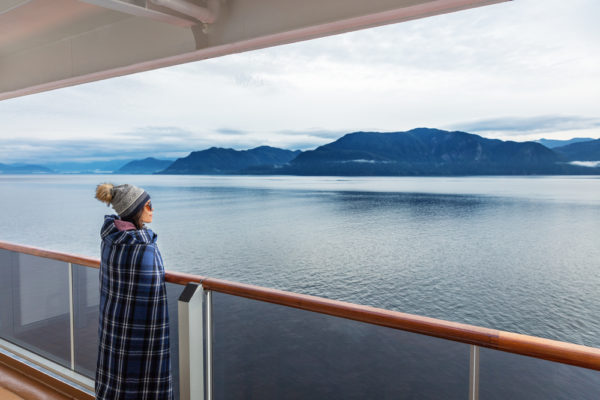Looking for an easy way to remember port and starboard? If you haven’t spent much time onboard a ship, there is a chance that you might have heard of the terms “port” and “starboard” without being entirely sure what they mean. These terms refer to the left and right sides of the ship, respectively (unchanged irrespective of the direction you face), but this can be understandably difficult to remember.
The “port” side of the ship is on the left when facing the front of the ship, while the “starboard” side is on the right-hand side. There are numerous ways to remember this, by using the number of letters (left and port both have four letters), a rhyme, or other methods of association.
Keep reading to learn more about how to remember port and starboard, a little bit of history regarding the names, and whether it really all matters for a cruise ship passenger!

What Is Port & Starboard On a Cruise Ship?
When facing towards the front of the ship, port refers to the left-hand side of the ship, while starboard refers to the right-hand side. These designations remain in place irrespective of which direction you face and are assigned to the actual halves of the ship.
This means that if you face the back of the ship, the starboard side will be on your left-hand side while the port side will be on the right.
This allocation of the two sides of the ship helps to avoid confusion when referring to directions of the ship, as everybody can be certain which side of the ship is being referred to, irrespective of which direction they happen to be facing at the time.
Ships are built to be almost completely symmetrical, and interestingly the only side access onto the ship is usually from the port side of the ship.
The Origin Of The Terms “Port & Starboard”
The way in which the terms port and starboard came about is an interesting story that began before the invention of the rudder. Before rudders came into mainstream use, boats were controlled using a steering oar.
Because the majority of sailors at the time were right-handed, it made the most sense for the steering oar to be located on the right-hand side of the ship, located over the right side of the stern. Resultantly, the right side of the ship became known as the steering side.
The term “starboard” came about as a result of the combination of the words “steor” meaning “steer” and “bord” meaning the side of the boat. Hence, starboard was born.
As boats became larger with time, the steering oar became larger too, and as a result, it became somewhat easier to tie the boat to the dock on the opposite side to the oar. This became known as the “larboard,” which means the loading side.
In 1884, the Royal Navy decided that this name was too similar-sounding to “starboard,” and so it was replaced with the name “port” because it was the side usually facing the port, where supplies were brought onto the boat.

How To Remember Port and Starboard
Many people have a hard time remembering which is the port side and which is the starboard side of a ship. This can be reinforced through numerous methods, and you will be sure to find one that does the trick for you, however silly it may seem.
Is There An Easy Way To Remember Port and Starboard?
To start off with, legend has it that sailors of the past tended to have a girl (or a wife) in every port. Your wedding ring goes on your left finger, and so it’s easy to remember that the port side of the ship is on the left.
There is a children’s rhyme that states: Lucy Left lives in the port. Suzy Starboard rows to the right. Billy Bow is at the front. Stern Stan is at the back.
This rhyme helps you remember not only which is port and which is starboard, but it also helps you remember which terms refer to the back and front parts of the ship.
Another method for differentiating between port and starboard is by making use of the letter’s positioning in the alphabet. Because the letter L is close to the letter P, you can remember that the port side is on the left. Because the letter R is close to the letter S, you will remember that the starboard is on the right.
Port wine is another great way to remember. You could remember a sentence like “Is there any red port left in the bottle?” which simultaneously reminds you that port is on the left and that it is indicated by the color red. An alternate sentence could be, “Port is always left at sea, but never left at dinner.”
The word “Starboard” has two of the letter “R,” which could be a way of remembering “R” for “right.”
The number of letters is another good indication, with the word “port” having the same number of letters as the word “left.”
One really easy way to remember port and starboard comes from the origin of the terms. If you can remember that starboard means steering side and that most people are right-handed, you will easily remember that starboard is on the right-hand side of the boat.

Why Do Port and Starboard Matter?
These terms allow for orders and information on the ship to be given unambiguously, as there is no need to know which direction the person is facing. This is important, as it is essential that information can be passed between the systems of the ship with ease.
Using the terms left and right are too ambiguous and can easily lead to confusion because they are dependent on the location of the observer as well as the direction in which they are facing.
These naming conventions for the sides of a ship were laid down in order to help prevent collisions from occurring at sea. Because the port side of the ship is indicated with red lighting and the starboard side is indicated by green light, it is possible to know in which direction a ship is traveling.
This also allows for easier communication of messages between ships when referring to the sides of ships passing one another, for example.
Do Port and Starboard Matter For A Cruise Passenger?
The short answer? Not really.
Where this often comes up from the perspective of a cruise ship passenger is when trying to decide which cabin to select. Passengers often wonder whether a particular side of the ship will get better views. However, the port vs starboard question isn’t really the determinative factor. What matters most is which itinerary you are sailing, and thus which direction the ship will face on your specific cruise.

For most itineraries, you will likely have breathtaking views on both sides of the ship. On closed-loop cruises — cruises where the ship sails roundtrip out of the same port — the ship essentially doubles back along its route. So, there will be great views as some point of the sailing from both sides of the ship.
Moreover, ships can dock on either port or starboard side, depending on the layout of the specific port, the direction the ship sails on a particular itinerary, and individual government regulations applicable to the port. It’s also often up to the captain to choose how to position the ship in port.
One well-known itinerary where the port vs starboard question may have significance is when sailing on an Alaska cruise. Alaska cruises often sail in one direction rather than a roundtrip.
If you are on a northbound Alaska sailing, the ship typically sails up the coastline through the Inside Passage and along the Hubbard Glacier. If so, passengers on the starboard side of the ship usually have the best views.
If you’re on a southbound Alaska sailing, then the reverse usually holds true. The ship sails down the coast, so passengers on the port side of the ship will have better views of Alaska’s scenic coastline.
Conclusion
Whichever method you use to help you remember which side of the ship is starboard and which is port, you will soon be able to get it to stick, and it will quickly become second nature knowing which side is which.

